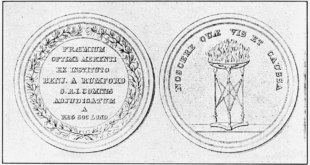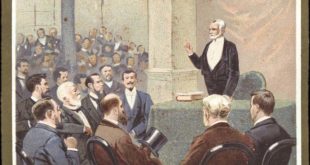
The mystery of life has puzzled and confounded humans since the first human began to contemplate his world. The religions of ancient societies were built around the seasons, the sun and the renewal of life as these were so clearly tied to survival; both of the human species through birth and death, and of the individual in the attainment of sustenance (ENERGY). SPONTANEOUS GENERATION or the idea that life routinely arises from non-life was a COMMON SENSE explanation of the miracle of life. It had the advantage of simplicity, ease of understanding and didn’t require any waste-of-time thinking. As science and the scientific method grew with the slow accumulation of knowledge, observant individuals began to consider the origin of life more deeply. Simple observations convinced many people that all the larger animals and plants produced life from previous life. Despite this, the mass of humans clung to the comfortable idea of SPONTANEOUS GENERATION Further, religions saw it as a convenient way to demonstrate the hand of God operating continuously in the WORLD. Some individuals, such as J.B. van Helment even described how one could make mice from grain, a jar and dirty rags by putting them together in a dark place for a few weeks and soon mice would appear in the jar. Other, more perceptive individuals, like F. Redi tested the common idea that maggots arise via SPONTANEOUS GENERATION on rotting meat. He placed a piece of meat in three jars, one he left open, one he corked tightly and the third he covered with a fine mesh gauze. Maggots only appeared in the open container, no matter how long he left the jars.
Figure 3. Redi’s experiment proving maggots are not spontaneously produced in rotten meat.
Redi’s experiment was important because of its eloquent simplicity. Anyone could repeat it and obtain the same clear results. Nevertheless, many people clung fiercely to the idea of SPONTANEOUS GENERATION, while others designed experiments to test it. In every case the results of the majority of these experiments indicated that SPONTANEOUS GENERATION did not occur. The intellectual ferment this controversy stirred up gradually evolved into the SCIENTIFIC METHOD as the various antagonists questioned each other’s assumptions and, more importantly, their experimental design. These arguments forced the designing of BETTER EXPERIMENTS (with good CONTROLS) and eventually persuaded all but the most recalcitrant believers to discard SPONTANEOUS GENERATION as an explanation for all higher life forms. Then, in the 1800’s the refinement of the microscope, through which people could see tiny life forms that they assumed were SIMPLE, gave SPONTANEOUS GENERATION proponents new life.
Again, flawed COMMON SENSE led reasonable people astray. As the existence of microscopic life was accepted, the assumption was that such life must be SIMPLE compared to higher, more COMPLEX life. The reasoning that followed this erroneous assumption was that since the microbes were small they must be simple & it followed that they were formed by SPONTANEOUS GENERATION, hence God was still at work creating micro-life. As we shall see in later discussions, small is not simple! The battle over SPONTANEOUS GENERATION raged anew both from the pulpit and the lab. A number of scientists performed elementary experiments in which they treated soups and broth’s, which left unheated would team with microbes after a few days, with heat to destroy any life present in them and asked the question: “Would new life arise in these sterile soups?” Spallanzani boiled “soup” in glass containers and melted the glass closed. The observation that nothing subsequently grew in this “heated” soup suggested that SPONTANEOUS GENERATION didn’t work. His detractors, rightly criticized his experiments, proposing that since air is necessary for life and since he had sealed the flask to air, obviously NO LIFE could develop. Others boiled soups and microbes grew, thus apparently supporting SPONTANEOUS GENERATION. But again the preponderance of data suggested that SPONTANEOUS GENERATION did not even apply to the “simple” microbes.
Figure 4. Pasteur’s swan-neck flask experiment. Pasteur’s SWAN NECK flasks put the nails in the coffin of spontaneous generation. The experiment was simple, & easily repeatable by anyone with modest means & the result unequivocal. However, it is important to note that few scientific experiments are this straight-forward.
In 1859 one of the fathers of modern microbiology, L. Pasteur (picture and short biography) decided to settle the question of SPONTANEOUS GENERATION once and for all. A genius at devising definitive experiments, Pasteur first drew the necks of glass flasks out so that they remained open to the air, but were bent so that air could only enter by a curved path. He then added broth and boiled it to destroy contaminating microbes. These flasks were then incubated and observed for months. He reasoned that the microbes in the air that could contaminate the sterile broth would be trapped on the sides of the thin glass necks before they reached the sterile broth. If SPONTANEOUS GENERATION didn’t occur no growth should take place. This is exactly what happened, the flasks remained sterile indefinitely, until Pasteur tipped the sterile broth up into the curved neck where he predicted the airborne organisms would have settled. After doing this the broths ALWAYS GREW MICROBES. These experiments ended the SPONTANEOUS GENERATION controversy because these experiment was so elegant and simple, and the results so clear, that anyone could repeat them.
Figure 5. Spore structure.
Later, an earlier problem, in which occasional heated-broths did not remain sterile, was explained with the discovery of the heat resistant bacterial #SPORES , some of which could can survive several hours of boiling without being killed.
Pasteur discovered many of the basic principles of microbiology and, along with R. Koch, laid the foundation for the science of microbiology. In 1857 Napoleon III was having trouble with his sailors mutinying because their wine was spoiling after only a few weeks at sea. Naturally Napoleon was distraught because his hopes for world conquest were being scuttled (pardon the pun) over a little spoiled wine, so he begged Pasteur for help. Pasteur, armed with his trusty microscope, accepted the challenge and soon recognized that by looking at the spoiled wines he could distinguish between the contaminants that caused the spoilage and even predict the taste of the wine solely from his microscopic observations. He then reasoned that if one were to heat the wine to a point where its flavor was unaffected, but the harmful microbes were killed it wouldn’t spoil. As we are aware this process, today known as PASTEURIZATION, worked exactly the way he predicted and is the foundation of the modern treatment of bottled liquids to prevent their #spoilage. It is important to realize that pasteurization is NOT the same as sterilization. Pasteurization only kills organisms that may spoil the product, but it allows many microbes to survive, whereas STERILIZATION kills all the living organisms in the treated material.
Pasteur also realized that the yeast that was present in all the #wine produced the alcohol in wine. When he announced this, a number of famous scientists were enraged, because the current theory of wine production was that wine formation was the result of SPONTANEOUS chemical changes that occurred in the grape juice. Pasteur was attacked furiously at scientific meetings, to the point where certain scientists did humorous skits about Pasteur and his tiny little yeast “stills” turning out alcohol. Pasteur had the last laugh however as people all over the world soon realized that if he was right they could control the quality of wine by controlling the yeast that made it. In a short period many others verified his observations and the opposition sank without a sound.
Figure 6. Budding yeast cell. Scientists who disagreed with Pasteur about the origin of ethanol in wine drew stills inside of the tiny yeasts to spoof his idea.
Pasteur also founded #MODERN IMMUNOLOGY when he realized that chickens became immune to a bacterial disease if injected with a “weakened” (avirulent) form of the pathogenic bacterium. While investigating chicken cholera, he injected some chickens with an old culture of the bacterial pathogen. When the chickens didn’t die he realized that the culture was no longer pathogenic, perhaps because it had died, so he repeated the experiment with a fresh culture. Again he injected a number of chickens with lethal doses of a virulent culture, but only some chickens died. In questioning his technician about the source of the chickens, he learned that those chickens that didn’t die when they were injected with the new, live, virulent culture were ones that had been previously injected with the “OLD, SICK” culture. For more information on Pasteur visit this site.
A case of the “Microbes Revenge”: During his investigation on bacteria two of Pasteur’s daughters and his father died of #Typhoid fever.
In one of those flashes of genius that can change the course of history Pasteur realized that the OLD CULTURES had IMMUNIZED the chickens. He reasoned that under adverse conditions a virulent microbe may lose its ability to produce a disease but still retain its ability to immunize the exposed host. He went on to produce vaccines against a number of scourges including anthrax and rabies using this approach. Still today, most vaccines are made with a modification of this general technique. Only with the rise of molecular biology are we developing newer methods of vaccine production and #immunization. Lately it has been discovered that Pasteur didn’t quite tell the whole truth about some of his data as he was under terrific pressure to show successful results. Do you think this is a problem in science today?
 Pasteur Brewing Louis Pasteur – Science, Health, and Brewing
Pasteur Brewing Louis Pasteur – Science, Health, and Brewing 


